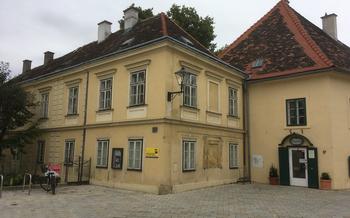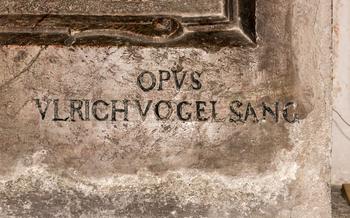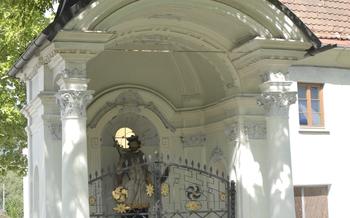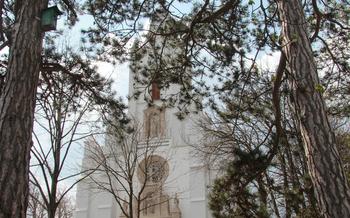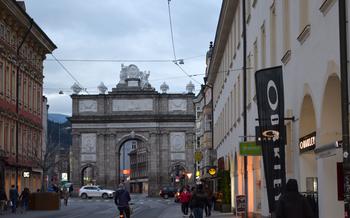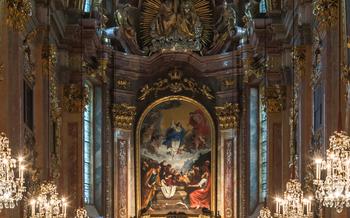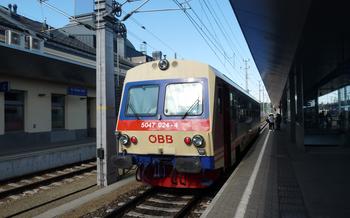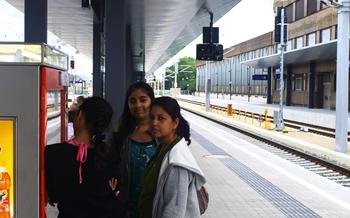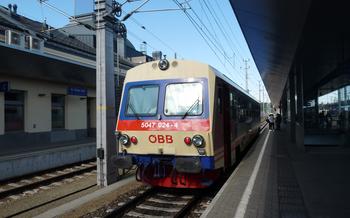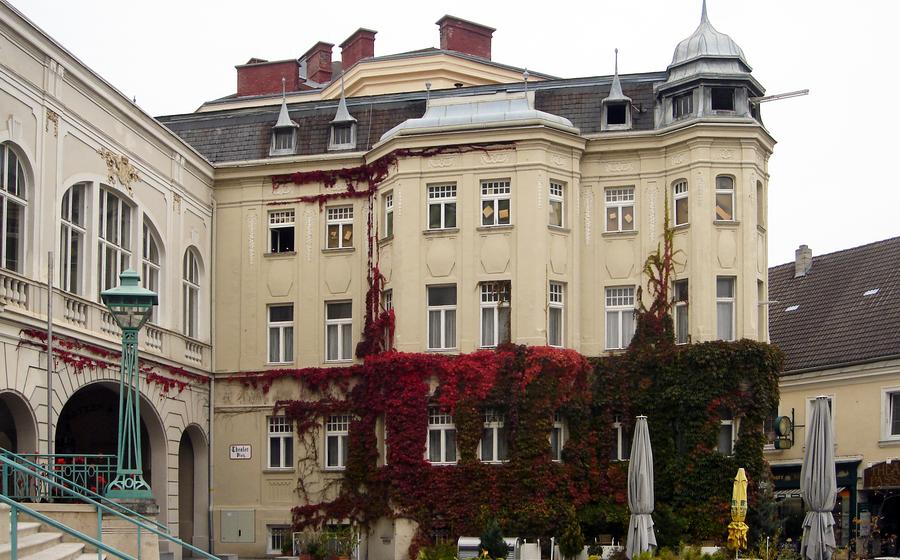
St. Jacob's Church
- History of St. Jacob's Church
- The Church's Exterior
- The Church's Interior
- The Altar of St. Jacob
- The Patron Saint
- Artistic Depiction
- Symbolism and Iconography
- The Pulpit
- The Organ
- The Frescoes
- Side Altars
- The Parish Museum
- Guided Tours
- Mass Schedule
- The Holy Year and Jubilee
- The Church's Surroundings
- Practical Information
- Insider Tip: Unveiling Hidden Treasures
History of St. Jacob's Church
St. Jacob's Church, a prominent landmark in Baden bei Wien, Austria, holds a significant place in the city's cultural and religious history. The church's origins can be traced back to the 12th century, when it was initially constructed as a Romanesque chapel dedicated to St. James the Greater, the patron saint of travelers. Over the centuries, the church underwent several renovations and expansions, reflecting the changing architectural styles and the growing importance of Baden as a spa town.
In the 14th century, the church was enlarged in the Gothic style, featuring pointed arches, ribbed vaults, and intricate stone carvings. During the 17th century, it was further expanded and remodeled in the Baroque style, showcasing elaborate stucco decorations, colorful frescoes, and a magnificent high altar. These renovations gave the church its current appearance, blending elements of Romanesque, Gothic, and Baroque architecture.
Throughout its history, St. Jacob's Church has undergone several major renovations and restorations. In the 19th century, the church's exterior was restored, preserving its historic facade and unique architectural features. In the 20th century, the interior was extensively renovated, including the restoration of the frescoes, the altar, and the pulpit. These efforts ensured that St. Jacob's Church remains a well-preserved and cherished architectural gem in Baden bei Wien.
The Church's Exterior
The exterior of St. Jacob's Church is a testament to the grandeur and artistry of Gothic architecture. Its striking facade commands attention with its intricate details and harmonious proportions. The church's main entrance is adorned with a beautiful rose window, featuring intricate stone carvings and stained glass depicting biblical scenes. Above the entrance, a series of niches house statues of saints and apostles, adding to the church's rich visual narrative.
One of the most striking features of the exterior is the church's bell tower. Soaring high above the surrounding buildings, the tower is a symbol of the church's dominance in the cityscape. Its octagonal shape and intricate carvings make it a true architectural masterpiece. The tower houses a set of bells that chime melodiously, marking the hours and calling the faithful to prayer.
The church's exterior is further enhanced by a series of sculptures and reliefs that adorn its walls. These sculptures depict various biblical scenes and figures, adding to the church's overall visual appeal and providing a glimpse into its rich history and religious significance. Each sculpture is a work of art in its own right, showcasing the skill and artistry of the medieval craftsmen who created them.
The Church's Interior
The interior of St. Jacob's Church is a symphony of art and devotion, where every element contributes to the sacred atmosphere. The church's most striking feature is its stunning stained glass windows, which depict scenes from the Bible with vibrant colors and intricate details. These windows not only provide natural light but also serve as a visual narrative, inviting visitors to contemplate the stories of faith and redemption.
The walls and ceiling of the church are adorned with lavish frescoes and paintings, each telling a story from the life of Jesus, the saints, or the history of the church. These artworks are not merely decorative but also serve to educate and inspire the faithful. The high altar, the focal point of the church's interior, is a masterpiece of intricate carvings and sculptures. It depicts the crucifixion of Jesus, surrounded by angels and saints, and is a testament to the skill and devotion of the craftsmen who created it.
The Altar of St. Jacob
In the heart of St. Jacob's Church, the altar dedicated to the church's patron saint, St. Jacob the Greater, stands as a testament to his legacy and profound significance. The altar, a masterpiece of artistry and devotion, is an awe-inspiring sight that draws the attention of visitors with its intricate carvings, vibrant colors, and profound symbolism.
The Patron Saint
St. Jacob, also known as St. James, was one of the twelve apostles of Jesus Christ. He held a prominent position among the disciples, earning him the title "Son of Thunder" for his fiery zeal and unwavering dedication to his faith. St. Jacob's martyrdom in Jerusalem around 44 AD made him the first of the apostles to be martyred, solidifying his status as a revered figure in the Christian tradition.
Artistic Depiction
The altar of St. Jacob captures the essence of the saint's life and martyrdom with remarkable precision. The centerpiece of the altar is a stunning statue of St. Jacob, rendered with exquisite detail and lifelike expressions. The statue depicts the apostle in his traditional attire, complete with a pilgrim's staff and a scallop shell, symbols associated with his pilgrimage to Santiago de Compostela in Spain.
Symbolism and Iconography
The altar of St. Jacob is a treasure trove of symbolic elements that convey deep religious meanings. The scallop shell, prominently displayed on the statue, represents St. Jacob's role as the patron saint of pilgrims, particularly those who undertake the arduous journey to Santiago de Compostela. The staff, another significant attribute, symbolizes his role as a guide and protector of travelers.
The altar's intricate carvings depict scenes from St. Jacob's life and martyrdom, serving as a visual narrative of his faith and sacrifice. These carvings, with their expressive figures and dynamic compositions, remind visitors of the saint's unwavering devotion and the enduring impact of his legacy.
The Pulpit
In the heart of St. Jacob's Church, the pulpit stands as a testament to the power of oratory and the dissemination of God's word. Carved from rich mahogany, its intricate details showcase the artistry and craftsmanship of a bygone era. The pulpit's central position within the church emphasizes its significance as a platform for delivering sermons, teachings, and spiritual guidance to the faithful.
The pulpit's ornate carvings depict scenes from the Bible and parables of Jesus, serving as visual aids to enhance the preacher's message. Angels, saints, and other biblical figures adorn the pulpit, reminding the congregation of the divine presence that surrounds them. The intricate carvings add a touch of grandeur and solemnity to the pulpit, creating an environment conducive to contemplation and reflection.
Throughout history, the pulpit has played a crucial role in religious services. It is from this elevated platform that priests, ministers, and other religious leaders have delivered powerful sermons, expounded on scripture, and guided their congregations on matters of faith and morality. The pulpit has witnessed countless moments of inspiration, conviction, and spiritual awakening.
Today, the pulpit at St. Jacob's Church continues to serve its original purpose, providing a platform for the proclamation of God's word. Visitors to the church can marvel at its exquisite craftsmanship and imagine the countless sermons that have reverberated within its walls, leaving an enduring impact on the lives of those who have listened.
The Organ
The magnificent organ of St. Jacob's Church is a masterpiece of craftsmanship and a testament to the church's rich musical tradition. Constructed in the 18th century by renowned organ builder Johann Hencke, this Baroque masterpiece boasts intricate carvings, gilded embellishments, and a majestic sound that resonates through the grand space of the church.
The organ's façade, adorned with delicate carvings of angels and cherubs, serves as a visual prelude to the musical wonders within. Its three manuals and 36 stops provide the organist with a vast array of tonal possibilities, allowing for the creation of both delicate and thunderous soundscapes.
Over the centuries, the organ has played an integral role in the church's liturgy, accompanying countless masses, weddings, and special events. Its powerful sound has reverberated through the church's walls, inspiring awe and devotion among generations of worshipers.
In addition to its liturgical function, the organ has also been a source of musical delight for concertgoers. Renowned organists from around the world have performed on this historic instrument, showcasing its versatility and captivating audiences with their virtuosic skills.
The organ's grandeur and beauty are not merely confined to its visual and sonic attributes. It also holds historical significance, as it has survived wars, renovations, and the passage of time, remaining a beloved and integral part of St. Jacob's Church.
The Frescoes
The interior of St. Jacob's Church is adorned with breathtaking frescoes that captivate the eyes and transport visitors to a realm of biblical narratives. These stunning paintings, executed with exquisite artistry, depict scenes from the Old and New Testaments, bringing to life the stories of faith, hope, and redemption.
One of the most striking frescoes portrays the creation of the world, where God, with a divine gesture, brings forth the elements and separates light from darkness. Another masterpiece depicts the Annunciation, a pivotal moment when the Virgin Mary receives the news of her divine pregnancy from the Archangel Gabriel.
The frescoes in St. Jacob's Church are not mere decorations; they serve as a visual representation of the church's teachings and beliefs. They remind visitors of the sacred history that underpins the Christian faith and provide a glimpse into the spiritual realm that transcends the physical world.
Beyond their religious significance, the frescoes are also remarkable works of art. The vibrant colors, intricate details, and expressive figures showcase the talent and craftsmanship of the artists who created them. Each brushstroke seems to breathe life into the biblical scenes, inviting viewers to contemplate the deeper meanings and symbolism hidden within.
The frescoes in St. Jacob's Church stand as a testament to the enduring power of art and faith. They continue to inspire and uplift visitors, reminding them of the divine presence that permeates the sacred space and connects them to the eternal stories that have shaped human history.
Side Altars
In addition to the impressive high altar, St. Jacob's Church is home to a number of smaller side altars, each dedicated to a different saint. These altars are adorned with unique features and artistic elements that reflect their respective patron saints.
One of the most notable side altars is the Altar of St. Sebastian, located in the southern aisle. This altar features a stunning statue of the saint, depicted as a young man pierced by arrows. The altar is adorned with intricate carvings and decorative elements that symbolize St. Sebastian's martyrdom and his devotion to Christ.
Another noteworthy side altar is the Altar of St. Florian, located in the northern aisle. This altar is dedicated to the patron saint of firefighters, and features a striking statue of the saint extinguishing a fire. The altar is adorned with symbols of water and fire, representing St. Florian's power to protect against fire and other disasters.
The side altars at St. Jacob's Church are not only beautiful works of art, but they also hold historical and spiritual significance. Each altar represents a different aspect of the Catholic faith and the devotion of the local community. Visitors are encouraged to take the time to explore these side altars and learn more about the stories and legends associated with them.
The Parish Museum
In addition to the stunning architecture and artwork within St. Jacob's Church, visitors can delve deeper into its rich history by exploring the Parish Museum. This treasure trove of artifacts and exhibits provides a glimpse into the church's past and its significance to the community of Baden bei Wien.
The museum showcases a diverse collection of items, including ancient manuscripts, religious relics, and vestments worn by priests throughout the centuries. Visitors can admire intricate gold and silver chalices, ornate monstrances, and finely crafted statues that have adorned the church's altars.
One of the highlights of the museum is the collection of rare books and manuscripts. These include beautifully illuminated medieval missals, early printed Bibles, and historical documents that shed light on the church's role in the religious and cultural life of the region.
Through these artifacts, the Parish Museum offers a tangible connection to the past, allowing visitors to appreciate the enduring legacy of St. Jacob's Church and its enduring significance as a spiritual and cultural landmark.
Guided Tours
St. Jacob's Church offers guided tours in various languages, allowing visitors to delve deeper into its history, architecture, and religious significance. These tours are conducted by knowledgeable guides who share fascinating anecdotes and insights about the church's past and present.
Visitors can join a guided tour to learn about the intricate details of the church's exterior, including the symbolism behind the sculptures and the unique features of the bell tower. Inside the church, guides explain the stories depicted in the stunning stained glass windows and the significance of the high altar and its intricate carvings.
By taking a guided tour, visitors gain a deeper understanding of the church's role in the community and its importance as a spiritual and cultural landmark. These tours provide an enriching experience for those seeking to explore the rich history and beauty of St. Jacob's Church.
Mass Schedule
Regular masses are held at St. Jacob's Church throughout the week, providing an opportunity for visitors and locals alike to experience the spiritual significance of this sacred space. Masses are conducted in German, the official language of Austria, allowing visitors to immerse themselves in the local culture and traditions.
The church's mass schedule varies depending on the day of the week. On Sundays, masses are typically held in the morning and evening, catering to different preferences and schedules. During weekdays, masses are usually held in the morning, offering a peaceful and reflective atmosphere for those seeking solace and contemplation.
Attending mass at St. Jacob's Church is a unique and enriching experience that allows visitors to connect with the local community and share in the spiritual traditions of the Catholic faith. The church's stunning architecture, awe-inspiring artwork, and serene ambiance create a truly uplifting and meaningful experience for all who attend.
The Holy Year and Jubilee
In the Catholic tradition, the Holy Year and Jubilee hold immense significance. St. Jacob's Church has been a witness to these special celebrations throughout its history. The Holy Year, also known as the Jubilee Year, is a designated period of time when the Church offers special graces and indulgences to those who fulfill certain requirements. These requirements typically involve pilgrimage to specific holy sites, prayer, and acts of charity.
During the Holy Year, St. Jacob's Church becomes a significant destination for pilgrims from around the world. Special events, masses, and processions are held to commemorate the occasion. The faithful gather to seek spiritual renewal and to receive the blessings associated with the Jubilee.
For those who participate in the Holy Year celebrations at St. Jacob's Church, it is a profound spiritual experience. The church's historic and sacred atmosphere provides a powerful setting for reflection, prayer, and communion with the divine. The Holy Year offers a unique opportunity for spiritual growth and renewal, drawing countless pilgrims to this cherished place of worship.
The Church's Surroundings
St. Jacob's Church stands majestically in the heart of Baden bei Wien, a city known for its rich history, picturesque landscapes, and thermal springs. The church's surroundings offer a harmonious blend of cultural heritage and natural beauty, inviting visitors to explore and admire.
In close proximity to the church, visitors can find the renowned Casino Baden, a stunning architectural masterpiece dating back to the 19th century. This iconic building boasts an elegant facade, opulent interiors, and a vibrant atmosphere, making it a popular destination for entertainment and gaming enthusiasts.
Just a short walk away, visitors will discover the Baden Theater, a cultural gem that has hosted countless performances, concerts, and theatrical productions over the years. Its impressive architecture, ornate interiors, and world-class acoustics create a magical setting for artistic expression and cultural immersion.
Baden bei Wien is also home to the Römertherme, a modern thermal spa complex that offers a rejuvenating and relaxing experience. Visitors can indulge in the healing powers of the thermal waters, unwind in saunas and steam baths, and revitalize their bodies and minds in a tranquil environment.
The city's charming streets are lined with an array of shops, boutiques, and cafes, inviting visitors to browse for unique souvenirs, savor delicious local cuisine, and soak in the vibrant atmosphere.
St. Jacob's Church is thus not only a spiritual sanctuary but also a gateway to a world of cultural exploration, historical intrigue, and natural wonders. Visitors can seamlessly transition from the sacred to the secular, discovering the many treasures that Baden bei Wien has to offer.
Practical Information
Admission Fees and Operating Hours:
- Church:
Insider Tip: Unveiling Hidden Treasures
When exploring St. Jacob's Church, take a moment to venture beyond the main altar and discover the hidden gems that often go unnoticed. In a secluded corner, you'll find a small chapel dedicated to the "Holy Cross." This intimate space exudes a serene atmosphere, with intricate carvings and paintings adorning its walls. The chapel serves as a quiet sanctuary for prayer and reflection, offering a unique perspective on the church's rich history.
For photography enthusiasts, the church's exterior offers a wealth of captivating angles. Step outside and capture the church's majestic facade against the backdrop of Baden's vibrant cityscape. Don't miss the opportunity to photograph the intricate details of the bell tower, where you can spot gargoyles and other whimsical creatures perched atop its spires.
As you wander around the church, keep an ear out for the melodious sound of the organ. If you're fortunate, you might catch a glimpse of the organist practicing or performing during a service. The music fills the church with a divine resonance, creating an unforgettable experience.
Remember to dress respectfully when visiting St. Jacob's Church, as it is an active place of worship. It's customary to maintain silence and refrain from taking photos during religious services. By following these guidelines, you'll show respect for the sacred nature of this historic church.
